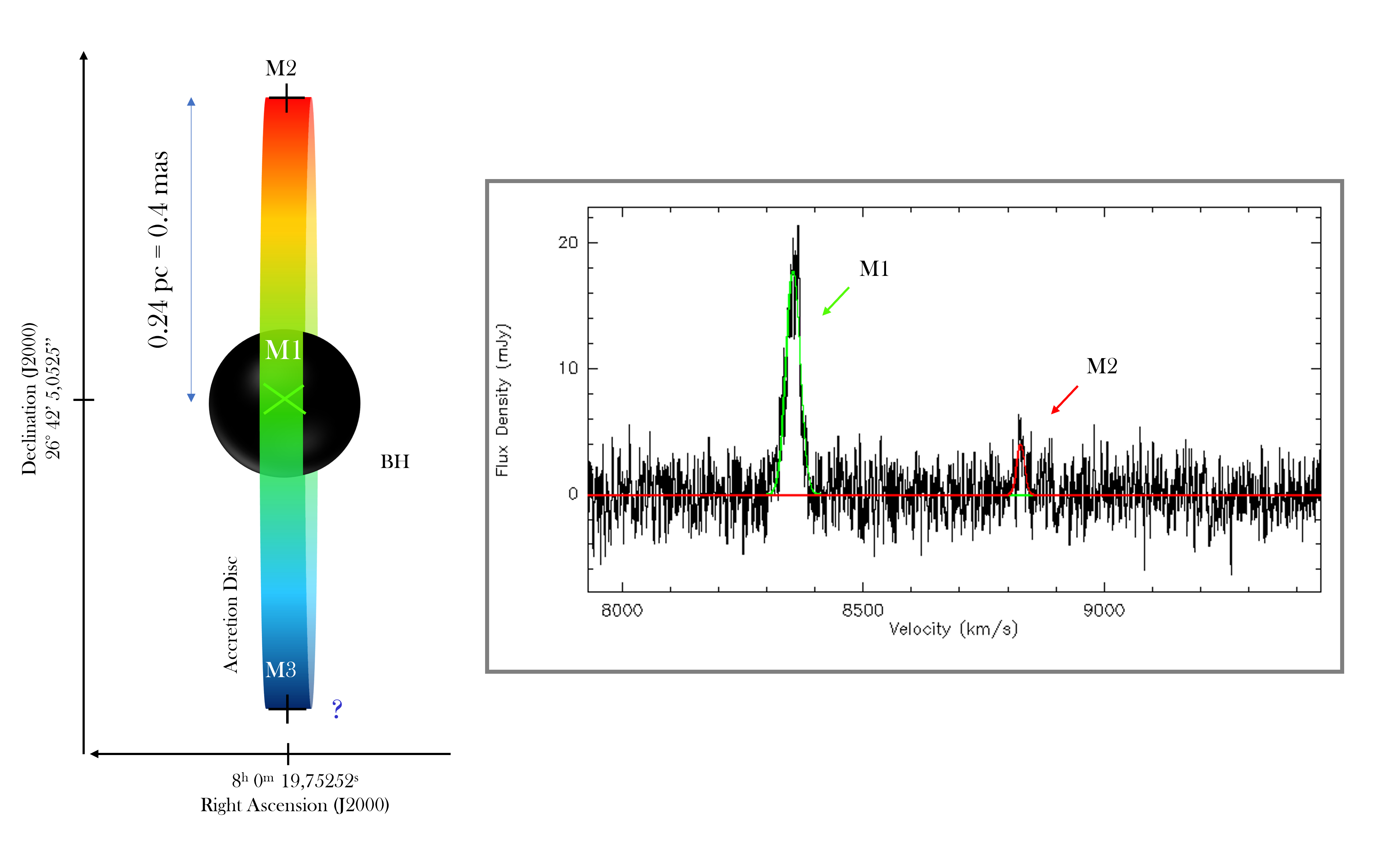
IC 485: a LINER galaxy with an elusive accretion disc!
Elisabetta Ladu
Masers are a unique tool with which to investigate the emitting gas in the innermost regions of active galactic nuclei (AGNs) and to map accretion discs and tori orbiting around supermassive black holes (SMBHs).
This is possible thanks to the high-angular-resolution measurements made with the very long baseline interferometry (VLBI) technique.
So far, the majority of the H2O masers have been found in radio-quiet AGNs (Seyfert 2 or LINERs) in the local Universe (z ≤ 0.05), although there are some exceptions (Tarchi 2012; Braatz et al. 2018).
IC 485 is classified as a LINER galaxy (Darling, 2017) at a distance of (122.0 ± 8.5) Mpc (Kamali et al. 2017) and hosts a bright H2O maser whose nature is still debated. In order to clarify and investigate the origin of the H2O maser, we observed the nuclear regions of the galaxy, at radio wavelengths, with the European VLBI Network (EVN) and with the Very Long Baseline Array (VLBA) in a multi-epoch, multi-band (L, C and K) campaign. Such measurements allowed us to investigate the continuum emission and derive the distribution and absolute position of the maser spots at mas scales for the first time.
Despite reaching the considerable sensitivity of a few micro-Jy, the EVN continuum maps did not show confident emission above 5σ, suggesting a diffuse morphology resolved out at the pc-scale. This seems to indicate that the nucleus of IC 485 hosts a radio-silent AGN or that the bulk of the unresolved and faint emission detected at kpc scales VLA scales is seemingly produced by enhanced star formation activity.
Noticeably, by taking profit of a resolution intermediate between that of the VLA and VLBI, very recent observations with the e-MERLIN seem to reveal slightly-resolved continuum emission, consistent in position with the VLA detection at 20 GHz by Darling (2017) and with the maser location observed by us (P. Castangia, Priv. Comm.).

Figure 1: Left panel: Portrayal of the disc geometry based on our observations of the maser emission. The edge-on disc, assumed to be in Keplerian rotation, is oriented north-south and rotating clockwise, as suggested by the color gradient of the disc, with the black hole at the center. The positions of the detected maser components M1 and M2 are marked with a cross ‘×’ and a plus symbol ‘+’, respectively. The supposed position of the weak blue-shifted maser component M3 is indicated with a plus symbol ‘+’ (see the text for details). Right panel: spectrum of the observed maser components M1 and M2. The thin green and red lines are the respective Gaussian fit of the spectral features.
The VLBA K-band spectral measurements detected two main groups of water maser features associated with the nuclear region of IC 485: a 'systemic' component, named M1 and a 'red-shifted' maser component centered at ~ 500 km/s from the recessional velocity of the galaxy, named M2 (Fig. 1, right panel).
The nuclear origin and the location of M1 and M2 suggest that the maser emission might originate in an edge-on accretion disc with a north-south orientation. In Fig. 1 (left panel), we show a simple portrayal that follows the scenario just described, under the assumption that the blue-shifted component tentatively detected in the single dish spectrum of Pesce et al. (2015) is located symmetrically opposite to the red-shifted one. In the case of Keplerian rotation, we can thus infer the size of the accretion disk and estimate the mass of the SMBH. From our calculations, these quantities are 0.24 pc and 1.2 × 107 M☉, respectively, which are consistent with those expected for a LINER galaxy. In order to confirm our scenario and, in particular, to detect also the weak 'blue-shifted' component, High Sensitivity Array (HSA) observations have been also recently acquired.
Overall, our study indicates that the maser in IC485 likely originates in material orbiting around a SMBH, adding a new candidate to the sparsely populated, though with a great relevance, class of disc-maser galaxies. Furthermore, the significant distance at which the host galaxy resides (greater than 100 Mpc) strengthens the potential impact of these studies also at larger red-shifts, in particular, by taking profit of the enhanced sensitivity of new radio facilities such as the SKA and the ngVLA (e.g. Tarchi et al., 2024).
References:
Braatz, J., Condon, J., Henkel, C., et al. 2018, in Astrophysical Masers: Unlocking the Mysteries of the Universe, eds. A. Tarchi, M. J. Reid, & P. Castangia, et al., IAU Symp., 336, 86
Darling, J. 2017, ApJ, 837, 100
Kamali, F., Henkel, C., Brunthaler, A., et al. 2017, A&A, 605, A84
Pesce, D. W., Braatz, J. A., Condon, J. J., et al. 2015, ApJ, 810, 65
Tarchi, A. 2012, in Cosmic Masers - from OH to H0, eds. R. S. Booth, W. H. T. Vlemmings, & E. M. L. Humphreys, 287, 323
Tarchi, A. et al. 2024, in Cosmic Masers: Proper Motion Toward the Next-Generation Large Projects eds. Hirota, T. & Imai, H. et al., IAU Symp., 380, 50
More information: Ladu, E., et al. 2024, A&A, 682, A25
Contact: elisabetta.ladu@inaf.it